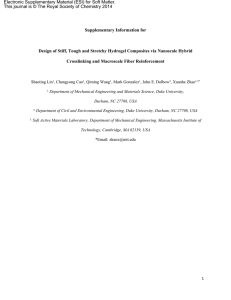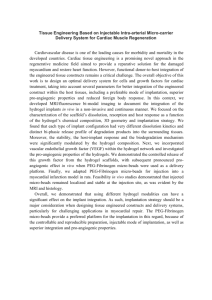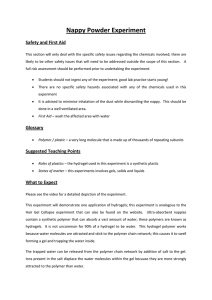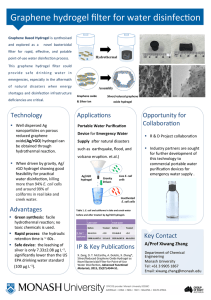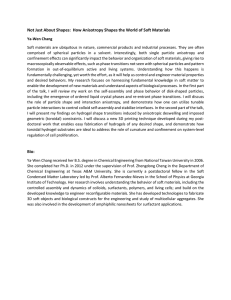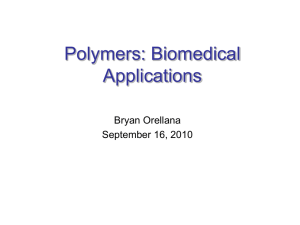Electronic Supplementary Material (ESI) for Soft Matter.
advertisement
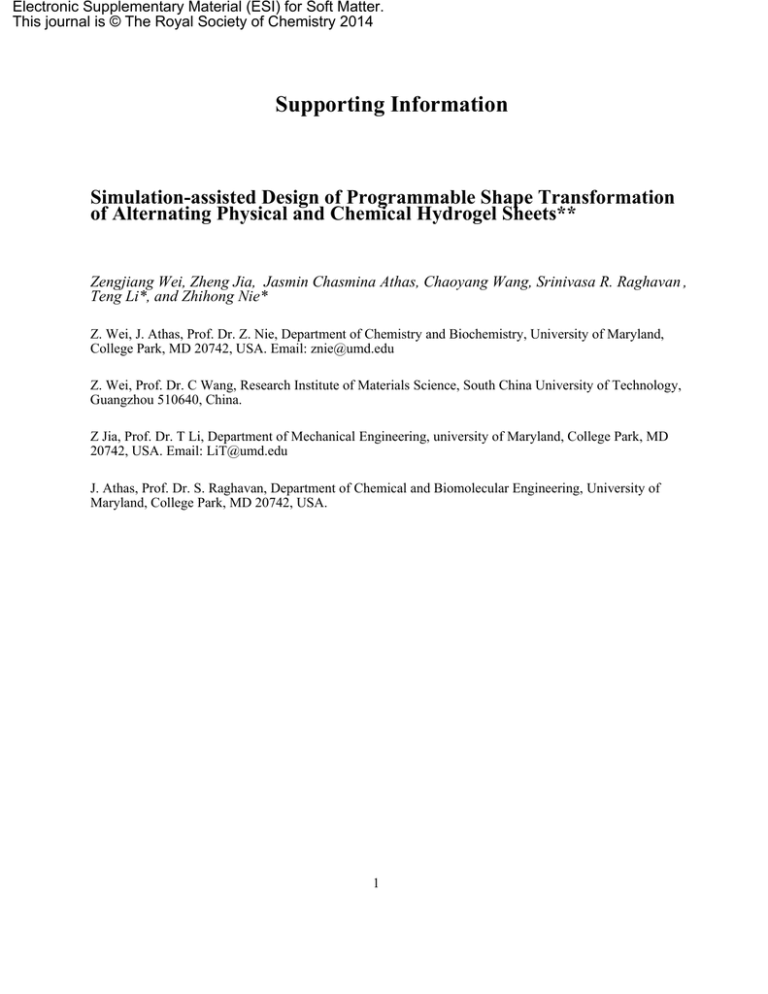
Electronic Supplementary Material (ESI) for Soft Matter. This journal is © The Royal Society of Chemistry 2014 Supporting Information Simulation-assisted Design of Programmable Shape Transformation of Alternating Physical and Chemical Hydrogel Sheets** Zengjiang Wei, Zheng Jia, Jasmin Chasmina Athas, Chaoyang Wang, Srinivasa R. Raghavan , Teng Li*, and Zhihong Nie* Z. Wei, J. Athas, Prof. Dr. Z. Nie, Department of Chemistry and Biochemistry, University of Maryland, College Park, MD 20742, USA. Email: znie@umd.edu Z. Wei, Prof. Dr. C Wang, Research Institute of Materials Science, South China University of Technology, Guangzhou 510640, China. Z Jia, Prof. Dr. T Li, Department of Mechanical Engineering, university of Maryland, College Park, MD 20742, USA. Email: LiT@umd.edu J. Athas, Prof. Dr. S. Raghavan, Department of Chemical and Biomolecular Engineering, University of Maryland, College Park, MD 20742, USA. 1 1. Materials N-isopropyl acrylamide (NIPAm), N,N'-methylene-bis-acrylamide (MBAA) were purchased from Sigma-Aldrich. 2-Hydroxy-4′-(2-hydroxyethoxy)-2-methylpropiophenone (Irgacure 2959) was purchased from BASF (German). The inorganic clay (a kind of Synthetic Hectorite) Laponite XLG was obtained from Southern Clay Products. NIPAm monomer was purified for twice in hexane using a recrystallization method. Water used in all experiments was purified by deionization and filtration with a Millipore (MA, USA) purification apparatus to a resistivity higher than 18.0 MΩ cm. 2. Fabrication of alternating BG/LG hybrid hydrogel sheets The alternating BG/LG hybrid hydrogel sheet was fabricated by photopatterning method. The detailed procedures were illustrated in Figure S1. Briefly, an opened rubber O-ring with 800μm thickness was first sandwiched between two glass slides to form a small chamber. The BG precursor was slowly injected into the chamber, and secured by clamps. A photomask with designed patterns was placed on top of the glass slide. The photomask was designed by FreeHand software and printed onto a polymer transparency by a desktop printer (HP laser Jet P3015). The chamber filled with hydrogel precursor was then exposed to ultraviolet (UV) light (Honle UV Technology, UVASPOT 400/T-BL) through the photomask, and selectively to photo-polymerize the hydrogel precursor within exposed area. The chamber was opened and the glass slide was rinsed with water to remove unpolymerized monomers to obtain parallel BG strips on the glass side. The LG precursor was then dropped onto the glass slide to cover the BG strips. The second exposure of the chamber under UV light polymerized LG precursor to produce the BG/LG hybrid hydrogel sheet (See Figure S2a). For the first polymerization: The BG film was synthesized by photo-initiated polymerization of a solution of NIPAm (3g), MBAA (0.2g) and Irgacure 2959 (0.085g) in a deionized water (17g) solution. Firstly, nitrogen gas was bubbled through the mixture for 30 minutes to remove any dissolved oxygen prior to use. After that, the mixture was injected into a reaction chamber, as described above. This reaction chamber was exposed through a mask for 60 s under ultraviolet light irradiation. In the process of photo-polymerization, ice bed was used to cool down the reaction system. Finally, the BG stripe was washed with the deionized water to remove the unreacted precursor to obtain BG stripes on a glass slide. For the second polymerization: The LG film was prepared by polymerizing a solution of NIPAm monomer (3g), Laponite 0.7g, and Irgacure 2959 (0.085g) in (17g) deionized water. After 2 the solution was bubbled with nitrogen gas for 30 minutes, the precursor of the LG was poured onto the glass slide covered with BG strips. The chamber was clamped and exposed for 60 sec under ultraviolet light irradiation. After the polymerization, the alternating BG/LG hybrid hydrogel sheet was obtained (see Figure S2a). The as-synthesized hydrogel sheet is not fully hydrated on the glass slide and remains flat on the glass slide, possibly due to the physical interactions between the gel and substrate. Upon the immersion of the hydrogel sheet in water, the sheet undergoes shape transformation to form a tubular structure at 25 oC. The detailed recipe of BG and LG was listed in Table S1. Table S1: Recipe of BG and LG Concentration (wt%) Components BIS-crosslinked gels (BG) laponite-crosslinked gels (LG) NIPAm 13 13 MBAA 1 - Laponite - 3 Initiator 0.5 0.5 3 Figure S1. Schematic illustration of the fabrication of the BG/LG hybrid hydrogel sheet using multiple-step photopatterning method. 4 3. Formation of the tubular and helical structures through shape transformation of 2D hydrogel sheets The alternating BG/LG hybrid hydrogel sheet was cut into rectangular samples along the long axis of the strips or along a 45o direction with respect to the long axis of the slender strips. The BG/LG sheet with different cutting angles was removed from glass slide and immersed into deionized water at room temperature. Depending on the cutting angle, the gel sheet transformed into either tubular structures or helical structures (Figure S2). a) b) c) Figure S2. (a) A BG/LG hybrid hydrogel sheet on a glass slide. (b,c) After the immersion of the gel sheet in DI water at room temperature, the hydrogel sheet transformed into tubular structure (b) or helical structure (c), depending on the cutting angle. Scale bars are 1cm. 5 4. Mechanical properties determined by rheology Rheological experiments were performed on a RDA-III strain controlled rheometer (TA Instruments). All rheological experiments were done at 25 oC using parallel plate geometry (25 mm diameter). A solvent trap was used to minimize drying of the samples. Dynamic frequency sweeps were conducted within the linear viscoelastic regime of the sample, which was determined separately from strain sweep experiments. 5. Simulation of the shape transformation of hybrid hydrogel sheets To simulate the deformation of hybrid hydrogel sheets, we employ the method developed by Hong et al. to implement a finite element method for gels [S1]. The Helmholtz free energy function according to Flory and Rehner [S2] is separable into contributions from stretching the polymeric network and mixing the polymer and the solvent: 𝑊(𝐹, 𝐶) = 𝑊𝑠𝑡𝑟𝑒𝑡𝑐ℎ(𝐹) + 𝑊𝑚𝑖𝑥(𝐶), (1) where 𝐹 is the deformation gradient tensor and 𝐶 is the concentration of the solvent in the gel. In the original Flory-Rehner model, 𝑊𝑠𝑡𝑟𝑒𝑡𝑐ℎ represents the free energy due to stretching of the polymeric network and is taken to be 1 𝑊𝑠𝑡𝑟𝑒𝑡𝑐ℎ = 𝑁𝑘𝑇(𝐹𝑖𝐾𝐹𝑖𝐾 ‒ 3 ‒ 2𝑙𝑜𝑔(𝐽)) 2 , (2) where 𝑁 is the number of polymer chains per unit volume, 𝑘𝑇 is the temperature in the unit of energy, and 𝐽 = 𝑑𝑒𝑡(𝐹). The free energy associated with mixing the polymer and the solvent is represented by 𝑊𝑚𝑖𝑥(𝐶) and is given by 𝑊𝑚𝑖𝑥 = 𝑘𝑇 𝑣𝐶 𝜒 [𝑣𝐶𝑙𝑜𝑔 ‒ ] 𝑣 1 + 𝑣𝐶 1 + 𝑣𝐶 ( ) (3) where 𝑣 represents the volume of one solvent molecule and 𝜒 is a dimensionless measure of the enthalpy of mixing, which describes the interaction between the solvent and the polymer. The molecular incompressibility requires that 𝑑𝑒𝑡(𝐹) = 1 + 𝑣𝐶, which applies a constraint between deformation and solvent concentration. ̂ 𝜇) can be To implement this hydrogel model in finite element method, another free-energy 𝑊(𝐹, introduced by Legendre transformation: 6 ̂ 𝑊(𝐹, 𝜇) = 𝑊(𝐹, 𝐶) ‒ 𝜇𝐶 (4) ̂ 𝜇), the Here, 𝜇 is the chemical potential prescribed by the environment. By introducing 𝑊(𝐹, equilibrium state of the gel can be expressed as ̂ = ∫𝐵 𝛿𝑥 𝑑𝑉 + ∫𝑇 𝛿𝑥 𝑑𝐴 ∫𝛿𝑊𝑑𝑉 𝑖 𝑖 𝑖 𝑖 (5) This equilibrium condition takes the same form as the weak-form equilibrium equation of ̂ 𝜇) is given, we can hyperelastic solids in ABAQUS. Therefore, once the explicit form of 𝑊(𝐹, implement a finite element method in ABAQUS through a UHYPER user-subroutine. More details about the finite element method implementation and the UHYPER user-subroutine can be found in Ref. S1. Combining Eqs. (1-4) and the molecular incompressibility gives the 𝑊̂ as ̂ 𝑊𝑣 1 𝐽 Χ 𝜇 = 𝑁𝑣(𝐹𝑖𝐾𝐹𝑖𝐾 ‒ 3 ‒ 2log (𝐽)) ‒ (𝐽 ‒ 1)log + ‒ (𝐽 ‒ 1) 𝑘𝑇 2 𝐽‒1 𝐽 𝑘𝑇 [ ( ) ] (6) As noted in the main text, Eq. (6) indicates that the system has two independent material properties: the normalized nominal density of polymer chains 𝑁𝑣 and the enthalpy of mixing 𝜒. The values of the material properties used in our simulations can be found in Table S2. When the gel with initial chemical potential 𝜇0 is submerged in a solvent with environmental chemical potential 𝜇, the gel absorbs (when 𝜇0 < 𝜇) or loses (when 𝜇0 > 𝜇) water until its chemical potential is equal to chemical potential of the external solvent 𝜇. In our simulations, we tune the 𝜇0 𝜇 initial chemical potential 𝑘𝑇 and the solvent chemical potential 𝑘𝑇 to simulate the volume change of the hybrid hydrogel sheets observed in the experiments. References: S1. Hong W., Liu Z. S., Suo Z. G. Inhomogeneous swelling of a gel in equilibrium with a solvent and mechanical load. Int. J. Solids Struct., 46 (2009) 3282-3289. S2. Flory, P.J., Rehner, J., Statistical mechanics of cross-linked polymer networks II swelling. J. Chem. Phys. 11 (1943), 521–526. Table S2: Parameters used in simulations 7 Table S3: List of four modes of shape transformation of hybrid hydrogel sheets a e i 25°C 40°C b c d f g h j k l 8 Figure S3. Simulated shape-transformation process of an as-made planar hybrid hydrogel sheet into a Mode 1 tubular structure in 25°C water (a-d). When immersed in 40°C water, such a Mode 1 tubular structure first unfolds and flattens (e-h), and further rolls in the opposite direction toward another tubular structure (Mode 2) (i-l). 9 Figure S4. The time-dependent shape transformation of hybrid hydrogel sheet in response to temperature change. When immersed in water at 40 oC, the tubular structure in Mode 1 opens up and flattens, then further rolls into a tubular structure with the BG strips exposed outside (denoted as Mode 2) (in red dashed frame). Upon the further immersion of the structure in Mode 2 in water at 25 oC, the tubular structure transits to Mode 1 (in green dashed frame). The transition between Mode 1 and Mode 2 are reversible and repeatable. Scale bar is 0.5 cm. 10 Figure S5. (a, b) Photos showing the dimension of the transformed structures of hybrid hydrogel sheets in 25oC water (Mode 1, tubular structure with the BG strips hidden in the interior of the tube) (a) and in 40oC water (Mode 2, tubular structure with the BG strips exposed outside) (b). (c,d) A close inspection of the hydrogel sheet in Mode 1 (c) and in Mode 2 (d). It is clear that the BG strips are wrapped inside in Mode 1 (c), while the outer surface of tubular structure in Mode 2 show undulation morphology with BGs at peaks and LGs at troughs (d). (e) The difference between LG strip width WLG and BG strip width WBG, as a function of time after a tubular 11 hydrogel sheet in Mode 1 first immersed in 40 oC water and then in 25 oC water. Optical images in (e) show the reversible transition from Mode 1 to Mode 2 and back to Mode 1. Figure S6. The time-dependent shape transformation of hybrid hydrogel sheet in response to the concentration of salt in solution (corresponding to ionic strength). When immersed in 1M NaCl solution, the tubular structure in Mode 1 opens up and flattens, then further rolls into a tubular structure with the BG strips exposed outside (denoted as Mode 2) (in red dashed frame). Upon the further immersion of the structure in Mode 2 in pure water (without NaCl), the tubular structure transits to Mode 1 (in green dashed frame). The transition between Mode 1 and Mode 2 are reversible and repeatable. The temperature is 25 oC. Scale bar is 1cm. 12 Figure S7. (a, b) Photos showing the dimension of the transformed structures of hybrid hydrogel sheets in pure water (Mode 1) (a) and 1M NaCl solution (Mode 2) (b). (c,d) A close inspection of the hydrogel sheet in Mode 1 (c) and in Mode 2 (d). The temperature is 25 oC. 13 Figure S8. (A) Variation in the BG strip width WBG (red) and LG strip width WLG (dark), and (b) the difference between WLG and WBG, as a function of time after a tubular hydrogel sheet in Mode 1 was first immersed in 1M NaCl solution and then in pure water. Optical images in (B) show the reversible transition from Mode 1 to Mode 2 and back to Mode 1. 14 Figure S9. The dimension of the hybrid hydrogel sheets in a NaCl solution with different concentration of salt. Scale bar 1.5cm. Figure S10. The length of the hybrid hydrogel sheet (left y-axis) and the variation in the length of the hydrogel sheet (right y-axis) as a function of the concentration of NaCl in an aqueous solution. Inset images show the shape-transformed 3D structures. 15 Figure S11. The time-dependent shape transformation of hybrid hydrogel sheet in response to ethanol solvent (in red dashed frame) at 25 oC. When immersed in ethanol, the tubular structure in Mode 1 opens up and flattens, then further roll about an axis parallel to the BG strips into another tubular structure with BG strips hidden inside (denoted as Mode 3). The hydrogel sheet recovers to its original Mode 1 in purewater at 25 oC (green dashed frame). The transformation between Mode 1 and 3 is fully reversible. Scale bar is 1.5cm. 16
